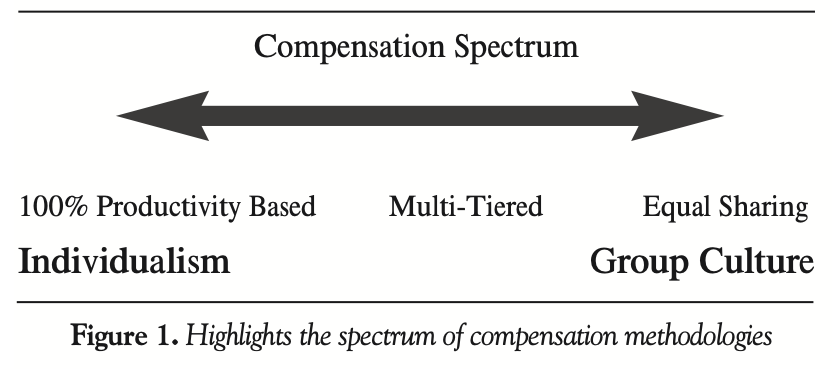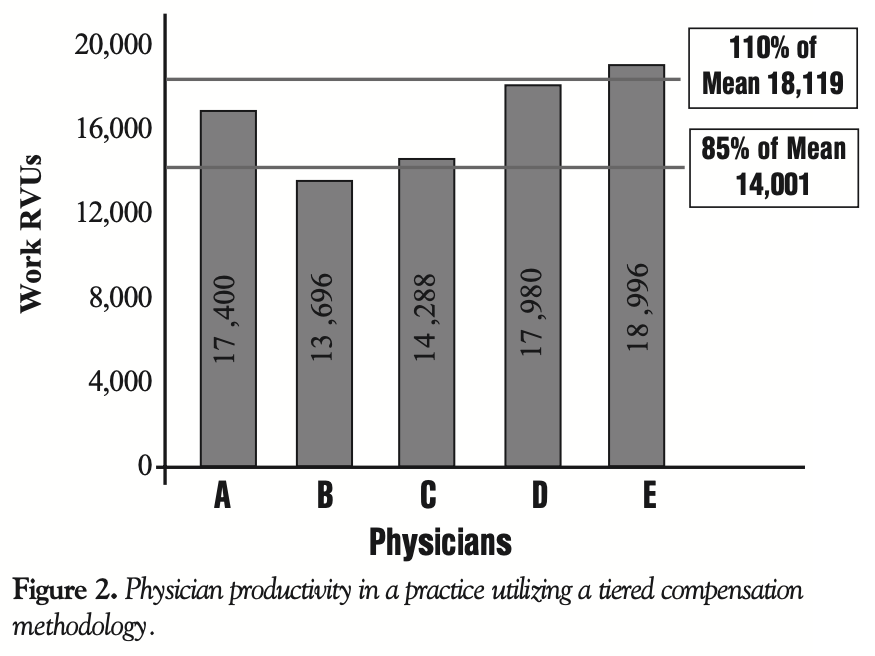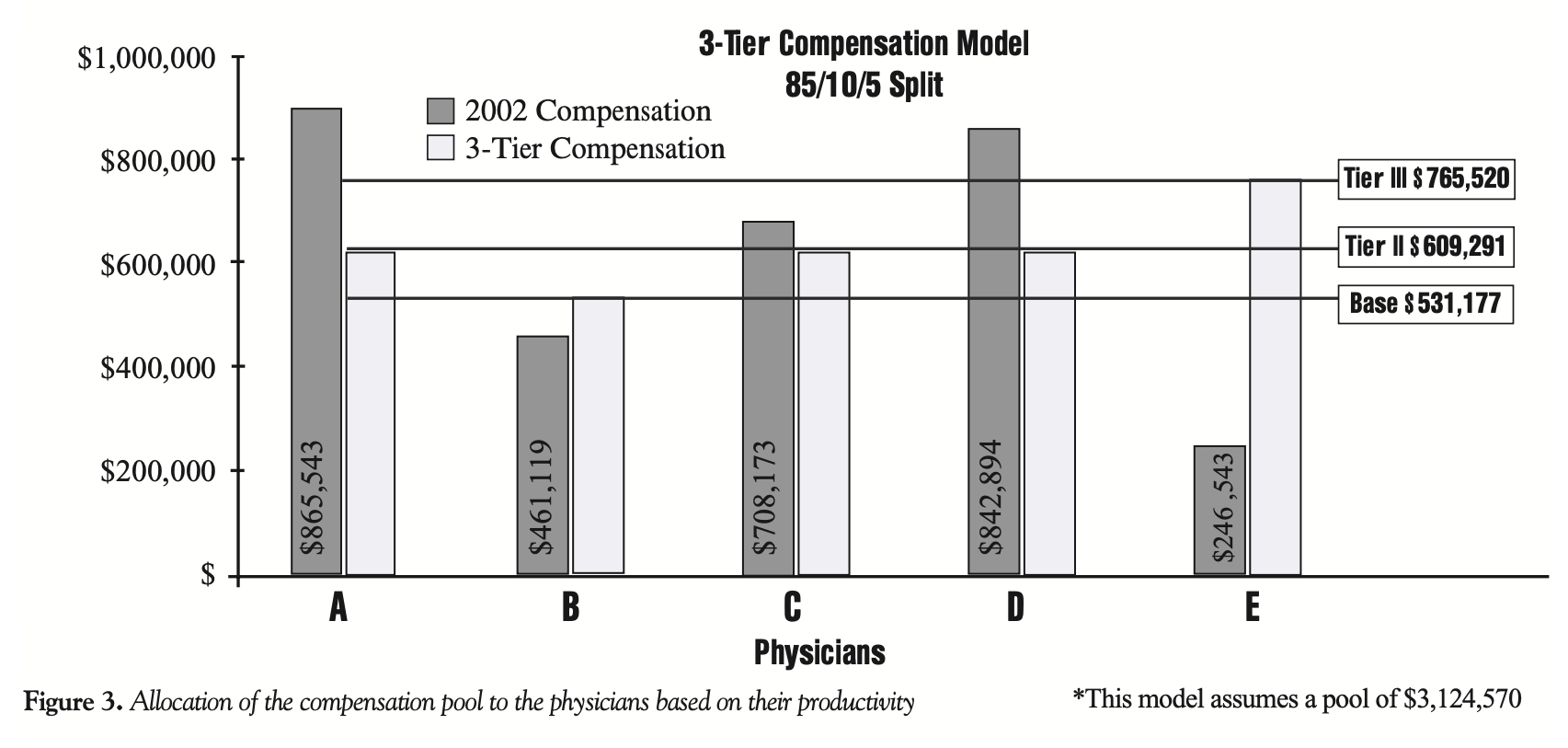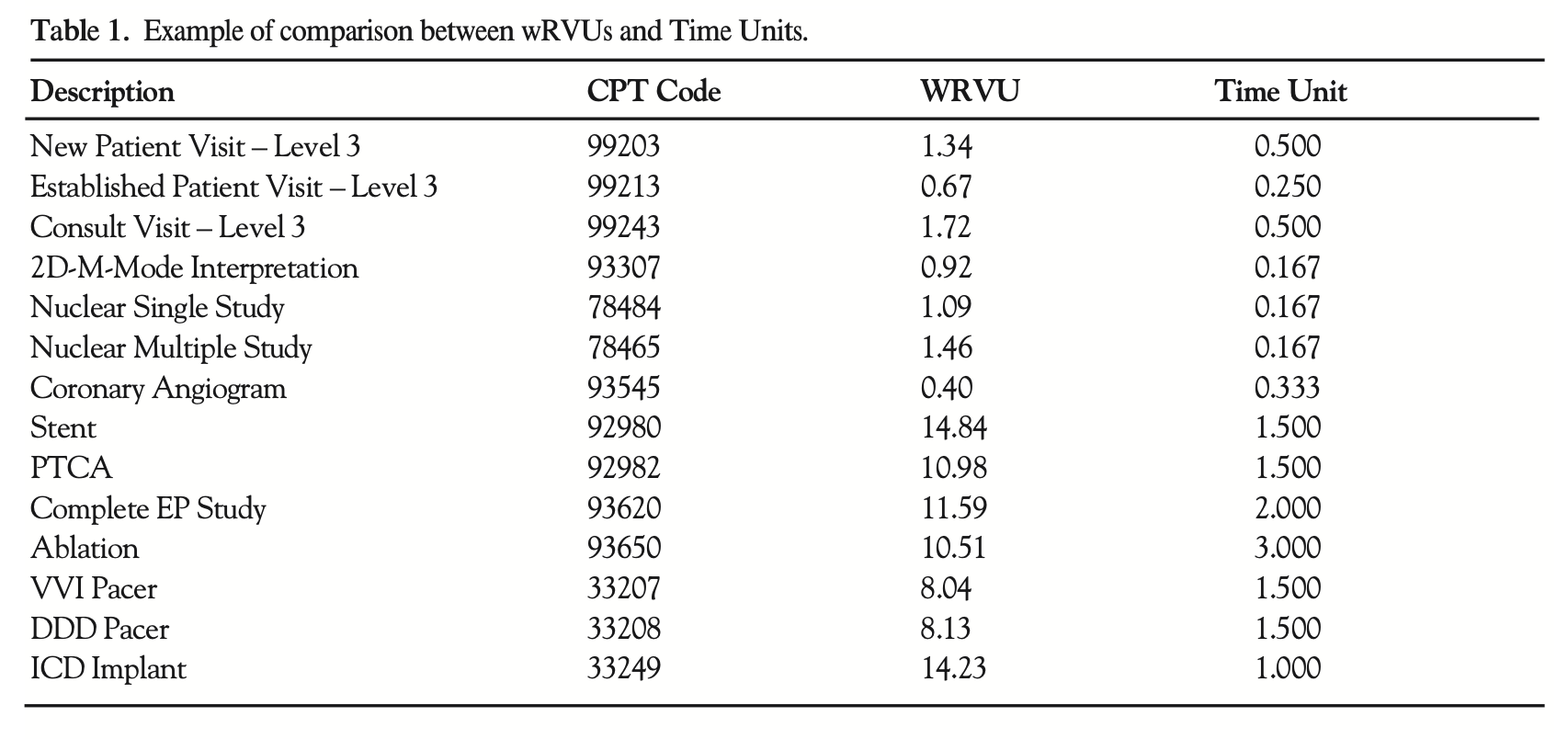ARTICLES
The Riner Group Resources
Articles

Innovations in Compensation Modeling
Innovations in Compensation Modeling
By Keely Meisinger, RN, MBA - Jere Palazzolo, MHA - Ronald N. Riner, MD, FACC
In times of increasing costs and declining reimbursement, physicians find themselves working harder for little or no increased financial reward. As revenues stagnate, compensation becomes an even timelier topic. Therefore, it is important to implement the right compensation plan in order to foster an environment of collaborative group culture and heightened productivity. As groups have consolidated and grown in size, the matter of rewarding the development of group culture and at the same time promoting increased productivity has become the centerpiece of many clinical practice controversies. This article focuses on a review of compensation basics, and some pragmatic and innovative approaches to this common dilemma.
Compensation plans cover the spectrum from 100% productivity based at one end to equal sharing at the other. There are literally thousands of compensation plans; as many different variations exist as there are groups and people inside those groups. Before deciding on a compensation model, group members need to determine their goals and values, and choose a plan that fits with the culture of their group. Indeed, the compensation plan is every bit a part of the practice’s mission and strategy, and needs to be carefully linked to it.

100% Productivity Based Compensation Model
Full productivity-based compensation is commonly referred to as the “eat what you kill” model. Each physician is an individual economic unit, covering individual expenses and credited with individual revenue. This productivity model generally promotes hard work and individual responsibility for cost containment. But, because it focuses solely on the individual, it may not foster an environment of a collaborative group culture. Indeed, disputes over revenue and cost allocation can arise, as well as intergroup rivalry, as physicians compete over patients and procedures to increase their individual bottom lines.
Equal Sharing Compensation Model
At the other end of the compensation spectrum are equal sharing plans. This form of compensation methodology shares expenses and revenues equally amongst all partners in the group. Equal sharing generally fosters an atmosphere of enhanced group culture and cohesiveness. It is easy to administer and simple for all members to understand. However, because it does not incorporate productivity as a component, it may not negate the “free-rider” effect whereby some members of the group coast on the backs of others. Equal sharing may not be as effective at encouraging individuals to work harder, and may not be appropriate in groups where large disparities in individual productivity exist. As groups grow in size, and partners may not see each other for weeks on end, there often is the concern that some are working harder than others — a concern not necessarily allayed by an “equal sharing” compensation formula. In reality, in some practices where these concerns arise, poor communication and lack of leadership may be greater issues than a flawed compensation program.
Tiered Compensation Model
In between the ends of the compensation spectrum are a host of blended methodologies. What follows is a discussion of a tiered method, which we are utilizing more and more in larger practices. Tiered compensation plans incorporate components of both shared revenue and productivity-based plans. This methodology begins by taking the full compensation pool (net revenue minus all practice expenses) generated by the group and divides the pool according to predetermined amounts of equal sharing and productivity. A percentage of the compensation pool is equally shared among participants, and the remaining funds are available to individuals based upon productivity. It is important to note that tiered compensation plans most readily accommodate full-time physicians and must be adjusted or altered to accommodate part-time physicians if the group desires their inclusion in the model.
Let’s examine one example of such a tiered compensation model: a 3-Tiered Compensation Model. This model divides participants into three tiers to determine their productivity and incentive status. The three main components of the model are as follows:
1. Tiers – Three tier levels are established within the model to determine which participants are eligible for distribution of funds within each tier. The first Tier is the equally shared portion of the model while Tiers II and III are incentive based. All participants who attain a particular Tier level will equally share the funds allocated to that Tier. This provides a strong group culture component even within the productivity tiers.
2. “Pool” – All income available for distribution to the participants goes into a pool of funds that is available across the plan. The pool is divided among the tiers on a set percentage basis. For example, the group may decide to allocate 85% of the pool to Tier I for equal distribution, and the remaining 15% (10% to Tier II, 5% to Tier III) as incentive compensation. Members of the group determine the percentage of funds to be allocated to each tier. The higher the % at risk, the more the model approaches an “eat what you kill” methodology and all that comes therewith.
3. Productivity – The plan is designed around a mean productivity level that is internally developed. Productivity can be measured several ways — in gross charges, professional collections, work RVUs or by what we are using more frequently - internally developed Time Units (discussed later). Once the mean is established, Tiers are determined based upon a percentage relative to the mean. Often the base level (Tier I) is fixed at 85% of the mean productivity, Tier III status is set at 110% of the mean, thus allocating productivity levels between 85 and 110% of the mean to Tier II. Individuals are apportioned to a tier based upon their actual productivity level in relation to the group mean productivity. Depending on the total number of physicians in the group, the majority of individuals often fall within Tier II. A standard is set requiring individual performance to remain above base level to allow continued participation in the model. Essentially, the base level of productivity (in this case 85% of the mean productivity of the group) is the minimal expected output for each participating physician.
Measuring Productivity
Before implementing the 3-Tier model, participants must decide how they wish to measure productivity. As stated, the measurement of productivity can be done in several ways. One option of measuring productivity is to measure gross charges. However, charges may be artificially inflated, and bear no relation to the actual work performed. Gross (or professional) collections are another potential measure of productivity. While cash collections are easy to monitor, they have many intrinsic flaws. Differences among patient population and payor mix, along with billing and collection inefficiencies, may affect individual physician collections. To counteract difficulties inherent to charges and collections, many practices currently utilize work RVUs. Work RVU levelsare designed by Medicare and consist of the relative value units involved in the work performed by a physician specific to a particular CPT code. Productivity measures based upon work RVUs can be easily monitored, implemented, and benchmarked as the units are pre-determined national standards and are applicable to all practices. However, many drawbacks to work RVUs also exist: they are weighted heavily towards procedures and some procedures have excessive weight relative to the amount of work being performed or time to perform the procedure (e.g. nuclear readings). In addition, no measurement exists for non-patient care activities such as administrative time and travel to outreach.
An example of tier allocation and pool distribution based on measurement of productivity utilizing work RVUs for a practice of 5 physicians is shown in Figures 2 and 3 below.


Sample Tiered Compensation Model
Figure 2 illustrates the individual annual total work RVUs for each of the five physicians in this group, as well as the thresholds for 85% and 110% of the group mean productivity. These thresholds become the points of demarcation between the compensation tiers, as illustrated in Figure 3. A very important point in this model and a contributor to the model’s effectiveness is that the tiers are a function of internal, not traditional external, benchmarks. Therefore, one’s ability to achieve a higher tier is based on a member’s work effort compared to his/her colleagues in the practice, not a national collection of practices impacted by variable circumstances. Everyone is expected to achieve at least the base threshold (85% of group mean), and failure to do so results in corrective action and/or eventual disqualification or adjustments of salary below the base.
The vast majority of the compensation pool (85% in this case) is equally distributed among all participating physicians. This 85% distribution greatly enhances group culture, but as illustrated, still leaves room for significantly higher compensation for the physician who works harder.
If one exceeds the base level of productivity, he/she qualifies for an equal share of both Tier I and Tier II. In this example, 10% of the total compensation pool is allocated to Tier II. Similarly, if one exceeds 110% of the group mean productivity, he/she qualifies for an equal share of the 5% allocated to Tier III, in addition to shares of Tiers I and II. It surprises most first-time observers that, by putting only 15% of the compensation pool at risk, there are potentially such large differentials among the tiers (in this case a range of over $230,000 from Tier I to III). These ranges will vary as more physicians qualify for the upper tiers. However, as more physicians reach Tiers II and III, the more the overall compensation pool, mean productivity level, and average physician compensation increase (all very good outcomes). The net result is that everyone earns more at all levels — “a rising tide floats all boats.”
Time Unit Development
In some practices, it may be worthwhile to develop what we consider a more advanced form of measurement for productivity, namely the use of Time Units (TUs) or Time Value Units (TVUs). Time Units measure work based upon the amount of physician time involved in complet- ing an activity. Anesthesia has adopted the use of Time Units for several years to account for the time spent with a patient from the initial pre-op consult until post-op monitoring is completed. This method of recording physician time can be applied across specialties to include patient visits and procedures. In reality the most valuable commodity any professional service firm or individual has at his/her disposal is time. Increments of time (based on segments of an hour) are assigned to each CPT code based upon internal measures designed by the group. The group as a whole determines, on average, how much time they feel is involved with a patient visit or procedure, and allocates that amount of time, thereby eliminating the procedural bias built into work RVUs. Groups can vary time units based upon complexity and severity of the CPT code. The downside to time units is that they must be internally developed, which can be a lengthy and timely process without proper guidance and facilitation. However, once developed, time units have many benefits: 1) they allow a group to customize work effort for its own needs; 2) they promote efficiency as the practice sets expectations for the time needed to perform the practice’s functions; 3) they can award practice approved administrative and travel time; and 4) they reward work effort, not just procedures. In short, they value the work effort of all members equally. Office-based physicians provide the funnel of patients to the practice and referrals to more lucrative procedures. Their effort is equally valuable to that of the procedurally based specialists. In a Time Unit model the time worked is what is credited, regardless of subspecialization. An example of a comparison between a practice’s time unit system and established work RVUs is shown in Table 1 below.

If the decision is made to implement a “Time Unit measurement” system, it is often desirable to initially measure productivity with work RVUs while transitioning to Time Units. Duringthis transition period group members should be evaluating the Time Unit values that have been established, and making changes to them as needed.
Conclusion
Every group must determine which compen- sation plan will best suit its needs while maintaining alignment to group goals and values. Regardless of the methodology chosen, satisfaction with compensation plans is most positively correlated with the understanding of the plan, and the perceived fairness of the plan. No compensation plan should be implemented without monitoring and potential for revision. Frequent revisions should be avoided, but yearly assessment and quarterly monitoring are desirable. A compensation plan does not need to be complex to be effective. Indeed, the easier to understand, the more effective. While there is no one perfect plan for all groups, there are several key characteristics of good plans as highlighted below:
• They are linked to group vision, values, goals and the practice’s strategic directions.
• Most have a productivity component — especially as groups grow in size and number.
• Work effort should be the primary measure rewarded. In a professional service firm, your most valued commodity is TIME.
• The best plans are understandable and simple for all members
• They allow the group to provide credit for valuable non-clinical activities (such as participation in meetings or group practice building activities such as regional growth, etc).
• They are monitored and reported upon regularly.
It is worth emphasizing again that compensation discussions need to be linked to a practice’s strategy. The ultimate goals of most groups, within the context of good patient care, are to enhance group culture, increase productivity, and reward effort and outcome. An appropriate, well thought out compensation plan will contribute to the achievement of these goals, and to the long-term success of the practice.
“It is neither wealth nor splendor; but tranquility and occupation which give happiness.”
Thomas Jefferson
REFERENCES
Moore KJ. A productivity primer. Family Practice Management May 2002.
Glass K and Anderson J. Relative value units: From A to Z (Part I of IV). Medical Practice Management March/April 2002.
Anesthesia Billing Guide. www.hgsa.com
Nelson J, Rider C, Biermann J, Schwartz S. Physician compensation models in large medical groups. Group Practice J 2001;50:16–19.
“Never be afraid to try something new. Remember that a lone amateur built the Ark. A large group of professionals built the Titanic.”
Dave Berry

Connect With Us
PHONE
TOLL FREE
Copyright 2023 • All Rights Reserved
Website designed and maintained by SPARKLER DIGITAL
